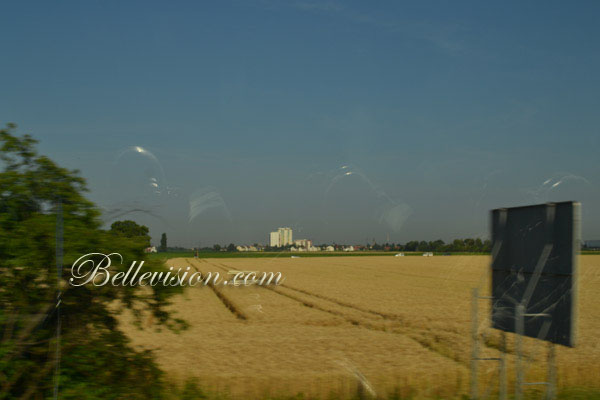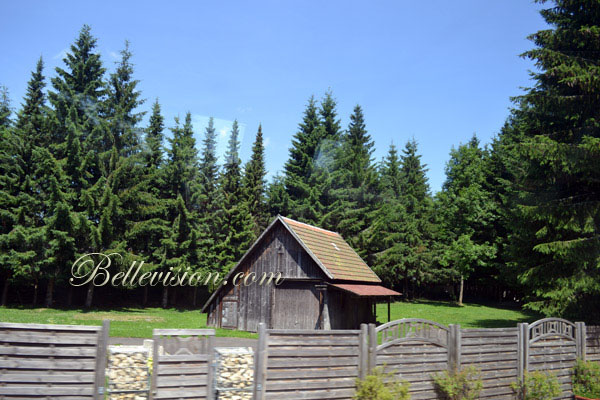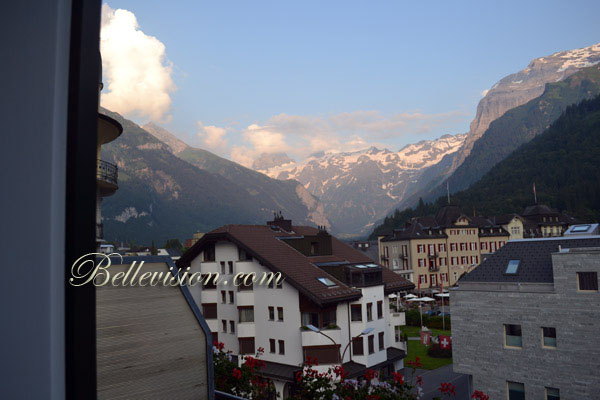

Wonders of Europe - Part 5: Through Black Forest to Cuckoo Clock Factory and Rhine Falls
By Dr. Eugene DSouza, Moodubelle
Bellevision Media Network
Udupi, 01 Sep 2013: Having spent the night at Mannheim, our tour programme for the 16 July was to proceed to the Cuckoo Clock Factory after travelling through the picturesque Black Forest and later to visit the wonderful Rhine Falls.
As we hit the road, and moved out of the Mannheim town, once again the beautiful landscape on both sides of the road was a treat to the eye. Unlike in earlier countries that we had visited, the topography of rural Germany presented a sight of uneven land with hills and mountain ranges could be seen at a distance. The land was well cultivated with various types of crops, ripened wheat being ready for harvesting.
After travelling for about two hours, we entered the Black Forest region which is a wooded mountain range in Baden-Württemberg, Southwestern Germany. It is bordered by the Rhine valley to the west and south. The highest peak is the Feldberg with an height of 1,493 meters (4,898 ft).
The Black Forest gets its name from its dark, slightly sinister canopy of evergreens. It is apparently so called because the trees here are so dense that it makes the ground appear black. In the fairy tale, this is where Hansel and Gretel encountered the wicked witch. The vast expanse of hills, valleys, rivers and forests stretch from the town of Baden to the Swiss border, and from the Rhine almost to Lake Constance.

.jpg)
.jpg)
.jpg)
.jpg)
.jpg)
.jpg)
.jpg)
.jpg)
.jpg)
The Black Forest mostly consists of pine and fir trees, chiefly a mixture of the European native Norway spruce and American imported Douglas fir and White Pine. As in the case of other forested regions, the Black Forest has had suffered due to large scale logging.. Due to logging and land use changes the forest proper is only a fraction of its original size and the original hardwood trees were replaced by fast-growing conifers.
The main industry in the Black Forest region is tourism. In addition to the towns and monuments of considerable tourist interest, the Black Forest comprises of a number of long distance footpaths. There are also numerous shorter paths suitable for day walks, as well as mountain biking and cross-country skiing trails.
Black Forest region has been renowned for clock makers for their precision clocks. Most of the mechanical clocks are now sold as antiquities as many factories were shut down after the First World War and the Second World War. A few factories survived the structural change. Among the existing Cuckoo Clock factories is the one belonging to the Drubba family at Titisee.
We covered 230 kilometers distance between Mannheim and Titisee in around three hours and after crossing the enchanting Black Forest region reached the Drubba Cuckoo Clock factory which is housed in an old building which also has a restaurant. As there was still time for lunch, Kunal Gorekar, our Tour Manager led us to the Cuckoo Clock Factory where a person named Amjad explained us the history behind the Drubba Cuckoo Clock factory and how these clocks are being prepared.
The famous Drubba factory is the world’s oldest manufacturer of Cuckoo Clocks. The Drubba Cuckoo Clock Factory itself is in the form of a cuckoo clock and at every hour, the window at the top opens and a wooden cuckoo bird comes out to cuckoo. This is followed by music while the figures just below the window start dancing. A 15-minute live demo on the history and making of the clocks takes us through the meticulous process of cuckoo clock-making. Amjad offered an interesting insight into the Cuckoo Clock Factory. He pointed out how the wood is seasoned before being carved in different designs and motifs before being assembled into a Cuckoo Clock.

.jpg)
.jpg)
.jpg)
.jpg)
.jpg)
.jpg)
.jpg)
.jpg)
.jpg)
.jpg)
.jpg)
.jpg)
.jpg)
.jpg)
.jpg)
.jpg)
.jpg)
.jpg)
Drubba was founded around 1955 in the Black Forest- Germany’s most popular holiday destination. The history of the Drubba family began when Klaus and Ursula Drubba came to the town of Titisee and started to work with the Hansen Company in the Titisee Hotel, which was then combined with a small shop and boat hire. It started as a shop selling souvenirs and offering boat trips on Lake Titisee. In 1973 the Drubba family became self-employed and enlarged the shop and added on a restaurant.
In 1978 the Restaurant "Zur Mühle" and the Black Forest Clock Center were built, which today holds the shop "Peter Drubba". Klaus and Ursula Drubba passed the business on to their sons, Olaf, Juergen, Peter and Thomas in 1996.
Today there are two hotels where several groups which stop over at Drubba for lunch and for souvenir shopping in the region of Regensburg. The clocks available at the our Black Forest Clock Center offers a wide selection of cuckoo clocks, wall clocks, grandfather clocks.
We went around viewing the verities of Cuckoo Clocks that were displayed on the walls as well as shelves. The façade of these clocks have different themes. They were intricately carved manifesting the artistic mastery of the craftsmen. There were also other sections in the show-room where tourists can view and purchase souvenirs of different categories such as dolls, ivory items and other items of tourist interest. The huge replica of a bear is an added attraction as tourists vie with each other to be photographed being in the grip of the bear.
From this old building which has the ‘Zur Muhle’ restaurant on the raised floor where we had our lunch, one can see the other two adjacent vintage buildings and also a railway bridge and beautiful mountain range with cluster of fir trees interspersed with green meadows.
After lunch and savoring the surrounding beauty of the nature, we headed towards the Rhine Falls which was next on our agenda. Once again as we hit the road and entered Switzerland the landscape and intermittent human settlements with typical houses with beautiful flower-beds over the windows and balconies presented a pleasing sight. Solar panels on sloping roofs of the houses to produce solar power and a harvester in the wheat field were the other sights in the sideline that attracted my attention as the bus proceeded towards the Rhine Falls.

.jpg)
.jpg)
.jpg)
.jpg)
.jpg)
.jpg)
.jpg)
.jpg)
.jpg)
.jpg)
.jpg)
.jpg)
.jpg)
.jpg)
.jpg)
.jpg)
.jpg)
In around one and a half hour we reached the Rhine Falls. As the bus parked in the parking lot, we could see at a distance the white foam formed due to the waterfall. Walking down the slope and crossing a small bridge we reached the point from where we had to take a boat to have a closer look of the Rhine Waterfall.
As we waited in the queue for our turn to board the boat, we could view enormous amount of milky foam crashing into a gorge below. It was an awesome sight to view through the thick fir trees the foaming bubbling water rushing down with a loud noise.
The Rhine Falls, located in Neuhausen, Switzerland, is Europe’s largest waterfall, falling from a height of approximately 75 feet and 492 feet at its widest point. Tourists flock to Rhine Falls yearly to enjoy the sound and view of thousands of gallons of rushing water moving the length of the falls in a single second. Many excursion and recreational options are available near the falls for both adventurists and laid-back tourists.
Tectonic shift and glacial activity that occurred thousands of years ago formed the waterfall on the Rhine River. Since then, both the Rhine River and Rhine Falls have supplied industry with water power. The first water-powered wheel mill was documented on the Rhine over 1,000 years ago. Technology evolved to 1880s with the construction of an aluminum plant near the Rhine Falls, followed by today’s hydropower station that provides energy to homes and businesses in the region. In addition to hydropower, Rhine Falls and the surrounding river area were an important European trade route throughout the Middle Ages up until the 1800s.
The nearest community is Neuhausen, where tourists can also view the Schloss Wörth castle. Boat trips can be taken up the Rhine to the falls. There are also viewing platforms with a spectacular view of the falls built on both sides of the Rhine. These are reached via steep and narrow stairs. Guided tours of various lengths start from Schloss Laufen on the Zürich side of the falls - a youth hostel is also located in Schloss Laufen. Various restaurants are located in Schloss Laufen, Schloss Wörth and the Rhine Fall Park.
As the mechanized boat bringing back the tourists from the previous trip touched the boarding point we hopped into the boat as the deck was cleared by the previous group. The captain slowly turned the boat and sailed towards the waterfalls in a circular route. As the boat moved closer to the waterfalls we could hear the thundering sound of the rapids and the sprinkle of the water on our body. I tried to be careful to click close up pictures of the waterfall while protecting the camera from the water-spray that was flying across due to the impact of the gushing water. The experience of going closer to the Rhine Falls was exhilarating and thoroughly enjoyable.

.jpg)
.jpg)
.jpg)
.jpg)
.jpg)
.jpg)
.jpg)
.jpg)
.jpg)
.jpg)
.jpg)
.jpg)
.jpg)
.jpg)
Returning from the close up experience of the Rhine Falls, we climbed back the steep path and halted at a food-outlet run by a Maharashtrian family where we had hot samosas and tea.
The third leg of our journey for the day from the Rhine Falls to Engelberg, a distance of around 145 kilometers was through the picturesque landscape of Switzerland and once again the beauty of nature through hilly region with cluster of fir and pine trees and carpet-like meadows, vast agricultural patches and townships presented a post-card picture of Switzerland. In the evening at around 6.30 pm local time, we reached our destination and settled down in the hotel that was strategically located presenting the best view of the pristine snow-bound mountains of Switzerland.
Engelberg is the leading mountain resort in central Switzerland. In the Middle Ages, Engelberg was known for the educational accomplishments of its Benedictine monastery, the Engelberg Abbey, whose school was well-known throughout the country. From the 19th Century, Engelberg became internationally known as a resort and spa, but is today visited as much for skiing as for its clean air. With its combination of modern sports facilities and alpine location, Engelberg attracts tourists both during summer and winter seasons.

.jpg)
.jpg)
.jpg)
.jpg)
.jpg)
.jpg)
.jpg)
.jpg)
.jpg)
.jpg)
.jpg)
.jpg)
.jpg)
.jpg)
.jpg)
.jpg)
.jpg)
We were in Switzerland for three days. Having completed a day of journey during which we crossed the Black Forest and viewed Cuckoo Clock Factory, experienced the Rhine Falls and had a wonderful opportunity of rural sight-seeing, we looked forward for the remaining two days of tryst with snow, first on the Titlis Mountain and second on the Jungfrau, known as the ‘Top of Europe’.
Also Read
Part 1 : ’Wonders of Europe’ - London in a Day
Part 2 : Memorable Tour Through Historic Paris and Enchanting Disneyland
Part 3: Onward to beautiful Brussels and classical Amsterdam
Part 4: Magnificent Cologne Cathedral-Architectural Wonder of Europe